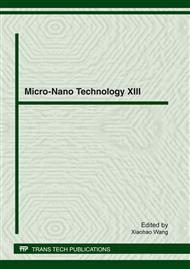p.272
p.277
p.287
p.293
p.298
p.303
p.308
p.312
p.318
Analysis of Broken Wires during Gold Wire Bonding Process
Abstract:
Wire bonding is one of the critical technologies of devices production, assembly and packaging in the microelectronic and MEMS field. During bonding process, the gold wires break easily, because the wires are repeatedly operated with high-speed. Therefore, the experiments were performed to analyze bonding process and the reason causing wire break. The results show that it is critical to prevent the broken wire to control the pressure wire pressure, the speed and angle of the pulling wire structure, the clamp gap, the capillary tip gap, and discharging energy in bonding process. the broken wire doesn’t occurs when the pressure wire pressure, the speed of the pulling wire structure, the angle of the pulling wire structure, the clamp gap, the capillary tip gap, the time and the current are 3-5g, 5rad/s and 10rad, 0.1-0.3mm, 1mm, 35ms and 10mA , respectively.
Info:
Periodical:
Pages:
298-302
Citation:
Online since:
February 2012
Authors:
Keywords:
Price:
Сopyright:
© 2012 Trans Tech Publications Ltd. All Rights Reserved
Share:
Citation:


